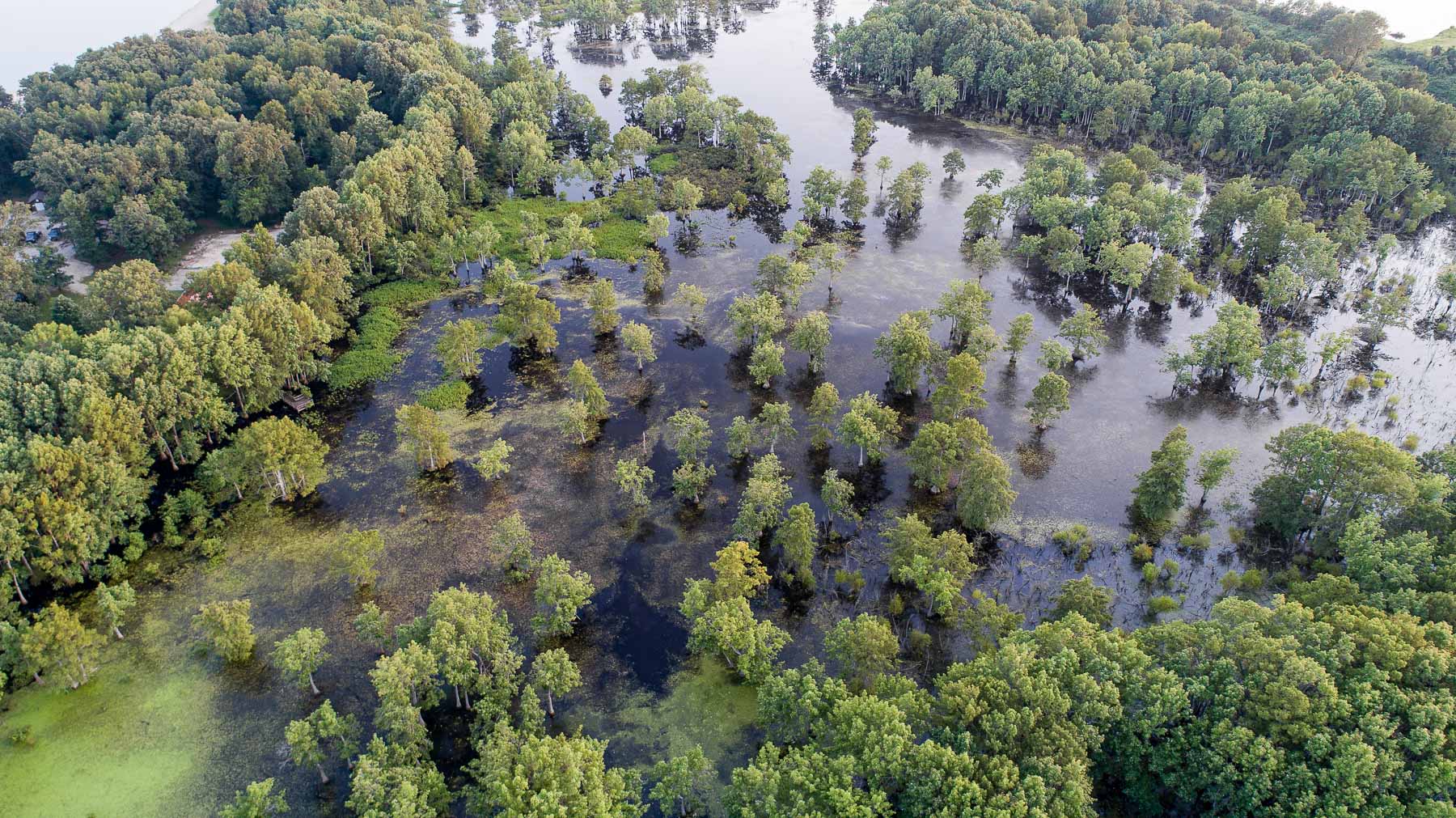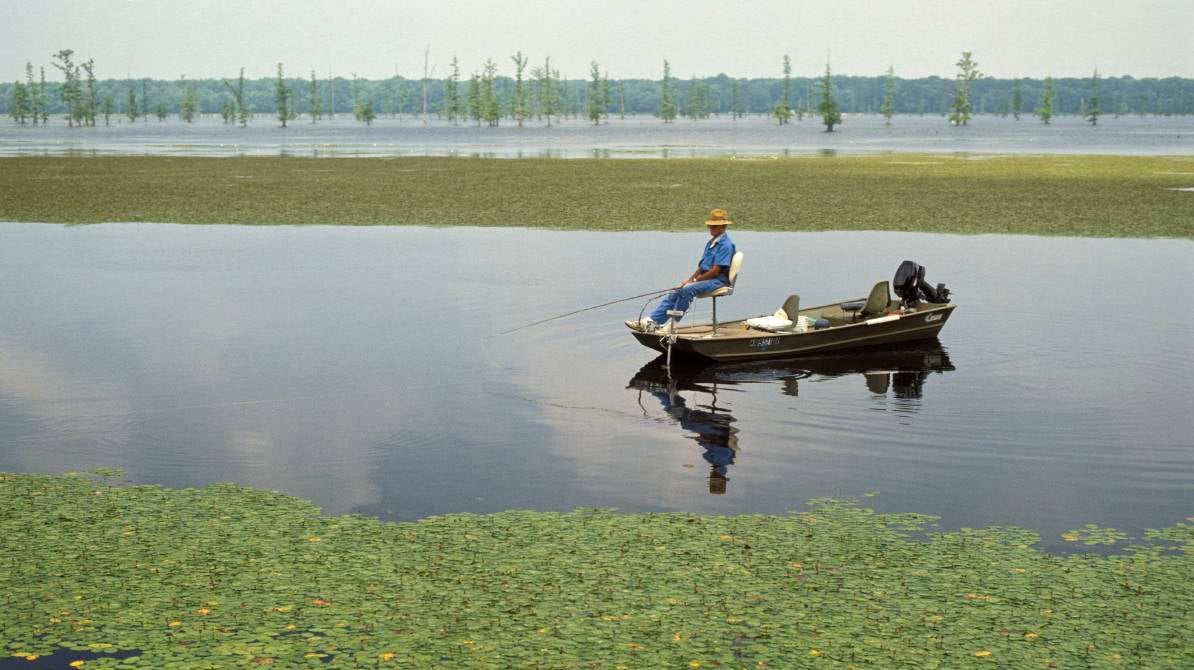
The Wetland Planning Initiative is a guide for how MDC approaches wetland management. It’s grounded on science-based methods and the importance of working with partners and citizens across the state. MDC is committed to first-rate management of the wetlands in its care and to building partnerships with other groups and private landowners to bring wetland conservation to local agriculture, businesses, and communities.
This page provides:
- An overview of the Wetland Planning Initiative
- Documents with full details about the Initiative
- Links to MDC research in wetlands
If you are interested in working with MDC to conserve or restore wetlands, please contact your local MDC office.
MDC staff can provide:
- Technical guidance
- Habitat improvement recommendations
- Cost-share information
Why Wetland Management Is Important
Wetlands provide a wide range of benefits to both people and wildlife, but in Missouri most wetlands have been altered or drastically reduced in size. Management and restoration of wetlands is necessary to maintain these vital systems.
Benefits of Wetlands
Ecological Services
Wetlands serve as biological filters. They:
- Improve water quality by cycling nutrients.
- Remove sediments and pollutants from surface waters.
- Store carbon.
Wetlands help regulate water for nearby land, streams, and rivers. They:
- Slow down and store runoff from rains.
- Reduce flood damage by slowing floodwater speeds and providing space to hold excess water.
- Slowly release excess water into nearby streams and groundwater aquifers.
Habitat
Wetlands are home to large numbers of plants and animals. They provide:
- Critical habitat for a wide range of amphibians, reptiles, insects, birds, fish, and mammals.
- Primary habitat for more than 200 Missouri species of conservation concern.
- Important areas for fish-spawning and -rearing along streams and rivers.
- Important habitat for migratory birds and overwintering waterfowl.
- Critical year-round habitat for species that rely on wetlands for their entire life cycle.
Recreation
Wetlands provide numerous recreational opportunities, including:
- Fishing
- Frogging
- Birdwatching
- Nature viewing and photography
- Hunting
- Trapping
- Canoeing/kayaking



MDC’s Approach to Wetland Conservation
MDC takes a holistic approach to wetland management and conservation. The goals of the Wetland Initiative encompass both ecological and social concerns. That is, they look out for the interests of people as well as the needs of wildlife, realizing these interests are interconnected. Management and conservation practices will be adjusted as more is learned through research and monitoring.
Guidelines for Carrying Out the Initiative
- Work with environmental processes rather than against them to create desired outcomes.
- Find and use opportunities for learning and continuous improvement.
- Coordinate and collaborate with partners at local, regional, flyway, and continental scales.
Areas of Focus
- Water stewardship
- Wetland infrastructure design and maintenance
- Habitat management
- Population management
- Landscape and watershed planning
- Public engagement
Goals
The Wetland Initiative lays out six goals for managing Missouri’s wetlands. Success hinges on understanding that ecological and social goals are interdependent and need to be pursued at the same time.
Title
Functioning Watersheds
Wetlands are part of a larger stream-floodplain-watershed system. Each piece of the watershed works as part of an interconnected whole. Stream diversions, levees, dams, urbanization, and other land uses have dramatically altered waterflow and natural processes within these systems.
MDC aims to maintain and improve how well Missouri’s watershed systems function.
Key actions for achieving this goal:
- Work with partners to set priorities for where and how to promote and restore natural stream flow and nutrient cycles.
- Recommend best practices for wetlands within agriculture, businesses, and communities as well as on MDC-managed lands.
- Balance current and future water needs with ecological processes.
- Work with natural land features to reduce flood damage to infrastructure, homes, and farms.
Title
Healthy Wetlands
Habitat Diversity
Wetlands provide the greatest benefits when they function as part of an interconnected whole rather than as fragmented pieces. Only 13% of Missouri’s original wetland habitats remain. Some types of wetlands have experienced greater losses than others; these include bottomland forests and wet prairies.
MDC aims to maintain and restore a variety of wetland habitats throughout the state.
Key actions for achieving this goal:
- Work with partners to develop plans for habitat restoration.
- Identify upgrades needed on existing MDC-managed wetlands.
- Identify staffing and financial needs to support wetland restoration and management.
- Reduce invasive species that harm wetland habitats and native plants and animals.
- Respond to changing climate and weather patterns that could affect Missouri’s wetlands and wetland-dependent plants and animals.
Wetland Connectivity
Wetlands provide the greatest benefits when they function as part of an interconnected whole rather than as fragmented pieces.
MDC aims to manage multiple wetland areas together as connected units of habitat.
Key actions for achieving this goal:
- Partner with private and public wetland owners and biologists to manage connected wetlands.
- Improve connections among streams, wetlands, floodplains, and uplands so plants and animals can move easily between them.
- Use connected wetlands and farmlands to support beneficial species like bats, birds, and invertebrates. These species aid in pest control and pollination of crops and other plants
Title
Thriving Plants and Animals
Wetlands support a wide array of plants and animals. In Missouri many wetland species have declined due to the destruction and degradation of wetland habitats. These species are important not only for the ecological benefits they bring, but also for recreation.
MDC aims to manage and restore wetlands so wetland species can thrive.
Key actions for achieving this goal:
- Work with partners to set goals for maintaining or restoring healthy populations of key species.
- Work with partners to determine the locations, quantity, and quality of wetland habitats.
- Work to provide enough habitat for species to meet their life history needs.
- Monitor wildlife populations and manage habitats to reduce wildlife disease outbreaks.
- Review and update practices for reducing human conflicts with Canada geese and other wetland species.
- Recommend regulations for waterfowl hunting that provide high-quality experiences while achieving population goals.
Title
Strong Partnerships
Wetland conservation depends on support from the conservation community and individual citizens.
MDC aims to create working partnerships with and among citizens, landowners, communities, conservation groups, and government agencies. Together, partners will work to conserve wetlands and promote the continued use and enjoyment of wetland habitats.
Key actions for achieving this goal:
- Create teams of MDC staff to:
- Enhance wetlands on MDC-owned lands through renovations and development.
- Guide management decisions about Canada goose populations, especially in urban areas.
- Guide public engagement and communication about wetlands statewide.
- Ensure high-quality waterfowl hunting on MDC-managed wetlands.
- Build interdisciplinary teams of MDC staff, other agencies, nonprofits, and private landowners to work toward improved wetland management.
- Assist wetland conservation organizations.
- Build on existing partnerships that support wetland conservation.
- Develop new approaches to strengthen partnerships with private landowners and managers.
Title
Shared Conservation Ethic
Missourians who believe in and support the preservation and wise use of natural resources will help pave the way for better conservation practices in wetlands.
MDC aims to improve public awareness of the value of Missouri’s wetlands and of the importance of citizen involvement in conserving wetlands.
Key actions for achieving this goal:
- Work with partners to assess and monitor public knowledge of and support for wetland conservation.
- Develop programs, multi-media communications, events, community resources, and school curricula that foster awareness of the benefits of wetlands and participation in conservation.
- Maintain or increase the number of individuals and communities that have a strong connection to wetlands.
- Monitor and adjust outreach to maintain or increase the number of Missourians who identify themselves as wetland conservationists, hunters, birders, and wildlife viewers.
- Adapt outreach strategies for communicating how wetland recreation and conservation are connected.
Title
Engaged Citizens
There is concern today about a growing divide between nature and society. People are spending less time in nature and are participating less in many forms of outdoor recreation.
MDC aims to encourage Missourians to enjoy wetland activities and take part in conservation efforts.
Key actions for achieving this goal:
- Develop approaches to encourage new audiences to enjoy and conserve wetlands.
- Provide a range of high-quality recreational experiences on wetlands, such as waterfowl hunting, birdwatching, and other wildlife viewing.
- Develop restoration plans with public use and recruitment in mind.
- Evaluate conflicts between different types of wetland users.
- Assess how public use impacts wetlands.
Read the documents below for full details about MDC’s approach to wetland management and building partnerships with other organizations and Missouri citizens to conserve wetlands throughout the state.
Together, the Wetland Strategic Guidance Document and the Wetland Implementation Plan direct MDC’s wetland management and conservation actions. They also guide efforts for working with conservation partners, communities, and interested landowners on wetland conservation projects.

























